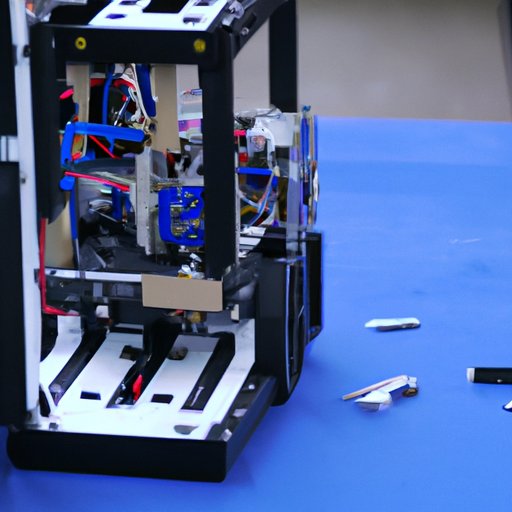Introduction
Robotics is an ever-evolving field of technology that has had a profound impact on our lives. But what exactly is a robot? The Oxford English Dictionary defines a robot as “a machine capable of carrying out a complex series of actions automatically, especially one programmable by a computer.” This article will provide an overview of robots and the role they play in modern society. It will look at the history of robots, their current applications, future potentials, and ethical considerations.
A History of Robots
The concept of robots dates back to antiquity. In Greek mythology, the god Hephaestus created mechanical servants known as Talos, who were made of bronze and could move around autonomously. Fast forward to the early 20th century, when Czech writer Karel Čapek introduced the word ‘robot’ into popular culture with his 1920 play R.U.R. (Rossum’s Universal Robots).
In the decades that followed, robots became increasingly sophisticated. In the 1950s, George Devol and Joseph Engelberger invented Unimate, the world’s first industrial robot. This marked the beginning of the automation revolution, leading to the development of more advanced robots such as Shakey the Robot in the 1960s, and ASIMO in the 2000s. Today, robots are used in a variety of settings, from manufacturing and healthcare to entertainment and education.
Robotics in Society Today
Robots have had a profound impact on modern society. According to a 2018 study by the International Federation of Robotics, there are currently over 4 million robots in operation worldwide. These robots are used in a wide range of industries, from manufacturing and logistics to healthcare and retail. They are also being used for tasks such as data collection, surveillance, and search and rescue operations.
Robots can help improve efficiency and accuracy in many areas. For example, medical robots can assist surgeons with precise movements during operations, while robotic vacuums can clean floors more quickly and thoroughly than a human. In addition, robots can help reduce the risk of accidents in hazardous environments, such as nuclear power plants and deep-sea oil rigs.
An Overview of Robotic Technology
Robots are composed of several different components. At the core of any robot is a control system, which is responsible for coordinating the robot’s activities. This typically includes a processor, memory, and software. The robot’s movements are controlled by actuators, which are powered by motors or air cylinders. Robots also use sensors to detect changes in their environment, such as temperature or motion.
Robots also use a variety of other hardware, including cameras, radars, and lasers. This helps them to detect and respond to their surroundings. For example, robots equipped with cameras can be used to inspect structures or identify objects. Radars and lasers can be used for navigation, allowing robots to safely navigate their environment.
The Future of Robots
Robots have the potential to revolutionize many aspects of our lives. One area of research is autonomous vehicles, which could potentially replace human drivers in the near future. Autonomous vehicles use a combination of sensors, cameras, and artificial intelligence (AI) to navigate their environment. They can detect obstacles and make decisions about the best route to take.
Robots are also being developed for medical applications. For instance, robotic prosthetics can be used to restore lost limb function. In addition, robots can be used to perform surgery with greater precision than humans. As AI continues to advance, robots may also be used to diagnose and treat illnesses.
Types of Robots
Robots come in a variety of shapes and sizes, and can be categorized based on their functionality. Industrial robots are used primarily in manufacturing and assembly. Service robots are designed to interact with humans and are commonly used in hospitality and healthcare. Finally, autonomous robots are self-directed and can operate without direct human intervention.
Examples of industrial robots include welding robots, which are used to weld parts together; pick-and-place robots, which move parts from one location to another; and assembly robots, which assemble parts into a finished product. Examples of service robots include vacuum cleaners, which clean floors; medical robots, which perform surgical procedures; and social robots, which interact with humans.
Ethical Considerations of Robotics
As robots become more sophisticated, ethical considerations must be taken into account. One issue is the potential for robots to replace human workers in certain industries, which could lead to job losses. Additionally, the development of advanced AI poses questions about the implications of giving machines decision-making capabilities.
Other ethical issues include privacy concerns, as robots can collect and store large amounts of data. Finally, as robots become increasingly autonomous, there are questions about how they should be regulated and who should be held responsible for their actions.
Conclusion
Robotics is a rapidly evolving field of technology that has had a profound impact on our lives. This article provided an overview of robots, from their history and current applications to their potential future uses and ethical considerations. Robots are used in a variety of settings, from manufacturing and healthcare to entertainment and education. As robots become more advanced, it is important to consider the implications of their use.
(Note: Is this article not meeting your expectations? Do you have knowledge or insights to share? Unlock new opportunities and expand your reach by joining our authors team. Click Registration to join us and share your expertise with our readers.)
